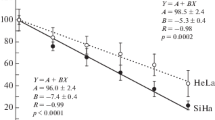Prognostic significance of the proportion of cancer stem cells in cervical scrapings from 38 patients with uterine cervical cancer before treatment and after irradiation in a total dose of 10 Gy was assessed for immediate results of radio- and combined chemoradiotherapy evaluated by the degree of tumor regression in 3-6 months after the treatment. Cancer stem cells were detected as cells with CD44+CD24low immunophenotype by flow cytometry. The proportion of cancer stem cells in patients with the complete tumor regression decreased by on average 2.2±1.1% after irradiation, while in patients with partial regression this indicator increased by on average 3.3±2.3% (p=0.03). Multiple regression analysis revealed two independent indicators affecting tumor regression: the stage of the disease (which is quite expected) and change in the proportion of cancer stem cells after the first irradiation sessions (R=0.60, p<0.002 for the model in the whole). The proportion of cancer stem cells before the treatment did not have prognostic significance.
Similar content being viewed by others
References
Chhabra R. Cervical cancer stem cells: opportunities and challenges. J. Cancer Res. Clin. Oncol. 2015;141(11):1889-1897.
Chopra S, Deodhar K, Pai V, Pant S, Rathod N, Goda JS, Sudhalkar N, Pandey P, Waghmare S, Engineer R, Mahantshetty U, Ghosh J, Gupta S, Shrivastava S. Cancer Stem cells, CD44 and outcomes following chemoradiation in locally advanced cervical cancer: Results from a prospective study. Int. J. Radiat. Oncol. Biol. Phys. 2019;103(1):161-168.
Eisenhauer EA, Therasse P, Bogaerts J, Schwartz LH, Sargent D, Ford R, Dancey J, Arbuck S, Gwyther S, Mooney M, Rubinstein L, Shankar L, Dodd L, Kaplan R, Lacombe D, Verweij J. New response evaluation criteria in solid tumours: revised RECIST guideline (version 1.1). Eur. J. Cancer. 2009;45(2):228-247.
Feng D, Peng C, Li C, Zhou Y, Li M, Ling B, Wei H, Tian Z. Identification and characterization of cancer stem-like cells from primary carcinoma of the cervix uteri. Oncol. Rep. 2009;22(5):1129-1134.
Fu HC, Chuang IC, Yang YC, Chuang PC, Lin H, Ou YC, Chang Chien CC, Huang HS, Kang HY. Low P16INK4A expression associated with high expression of cancer stem cell markers predicts poor prognosis in cervical cancer after radiotherapy. Int. J. Mol. Sci. 2018;19(9). pii: E2541. doi: https://doi.org/10.3390/ijms19092541
Gu W, Yeo E, McMillan N, Yu C. Silencing oncogene expression in cervical cancer stem-like cells inhibits their cell growth and self-renewal ability. Cancer Gene Ther. 2011;18(12):897-905.
Hou T, Zhang W, Tong C, Kazobinka G, Huang X, Huang Y, Zhang Y. Putative stem cell markers in cervical squamous cell carcinoma are correlated with poor clinical outcome. BMC Cancer. 2015;15. ID 785. doi: https://doi.org/10.1186/s12885-015-1826-4
Kim BW, Cho H, Choi CH, Ylaya K, Chung JY, Kim JH, Hewitt SM. Clinical significance of OCT4 and SOX2 protein expression in cervical cancer. BMC Cancer. 2015;15. ID 1015. doi: https://doi.org/10.1186/s12885-015-2015-1
Li J, Zhou BP. Activation of β-catenin and Akt pathways by Twist are critical for the maintenance of EMT associated cancer stem cell-like characters. BMC Cancer. 2011;11. ID 49. doi: https://doi.org/10.1186/1471-2407-11-49
Liu H, Wang YJ, Bian L, Fang ZH, Zhang QY, Cheng JX. CD44+/CD24+ cervical cancer cells resist radiotherapy and exhibit properties of cancer stem cells. Eur. Rev. Med. Pharmacol. Sci. 2016;20(9):1745-1754.
Lv Y, Yang L, Wang F. Chemoradiation therapy reduces aldehyde dehydrogenase 1 expression in cervical cancer but does not improve patient survival. Med. Oncol. 2015;32(5). ID 155. doi: https://doi.org/10.1007/s12032-015-0597-8
Xie Q, Liang J, Rao Q, Xie X, Li R, Liu Y, Zhou H, Han J, Yao T, Lin Z. Aldehyde dehydrogenase 1 expression predicts chemoresistance and poor clinical outcomes in patients with locally advanced cervical cancer treated with neoadjuvant chemotherapy prior to radical hysterectomy. Ann. Surg. Oncol. 2016;23(1):163-170.
Yao T, Lu R, Zhang Y, Zhang Y, Zhao C, Lin R, Lin Z. Cervical cancer stem cells. Cell Prolif. 2015;48(6):611-625.
Zhang J, Chen X, Bian L, Wang Y, Liu H. CD44+/CD24+-expressing cervical cancer cells and radioresistant cervical cancer cells exhibit cancer stem cell characteristics. Gynecol. Obstet. Invest. 2019;84(2):174-182.
Zhang XP, Cheng QH, Yang HJ, Qiao EQ. Research progresses in cancer stem cells of three common fertility-related female malignancies. Pathol. Oncol. Res. 2019;25(3):827-835.
Author information
Authors and Affiliations
Corresponding author
Additional information
Translated from Kletochnye Tekhnologii v Biologii i Meditsine, No. 3, pp. 191-194, September, 2019
Rights and permissions
About this article
Cite this article
Zamulaeva, I.A., Selivanova, E.I., Matchuk, O.N. et al. Quantitative Changes in the Population of Cancer Stem Cells after Radiation Exposure in a Dose of 10 Gy as a Prognostic Marker of Immediate Results of the Treatment of Squamous Cell Cervical Cancer. Bull Exp Biol Med 168, 156–159 (2019). https://doi.org/10.1007/s10517-019-04667-x
Received:
Published:
Issue Date:
DOI: https://doi.org/10.1007/s10517-019-04667-x




